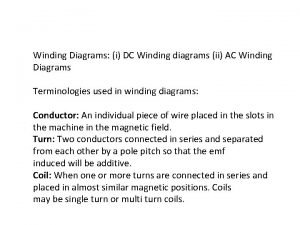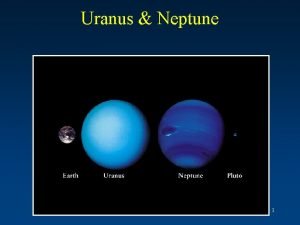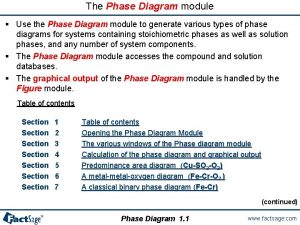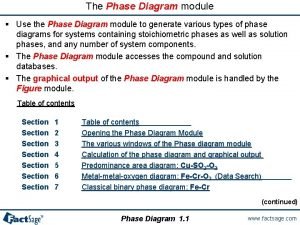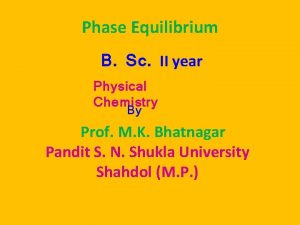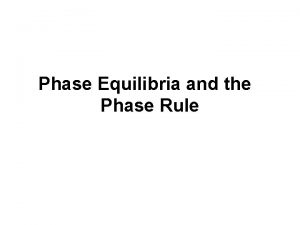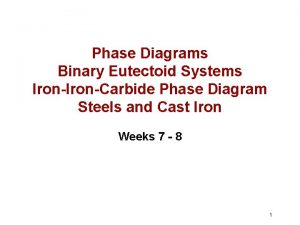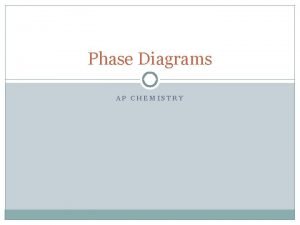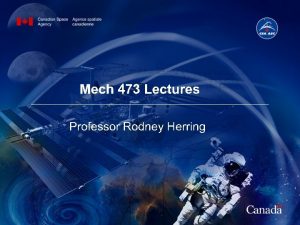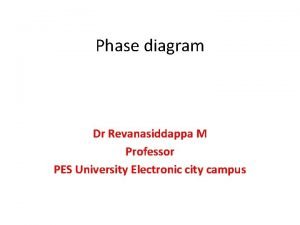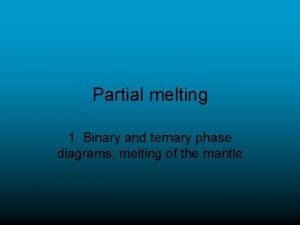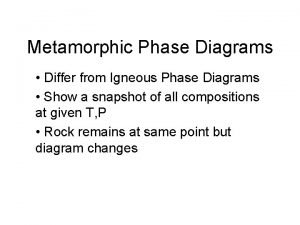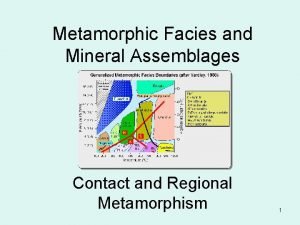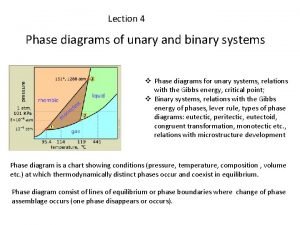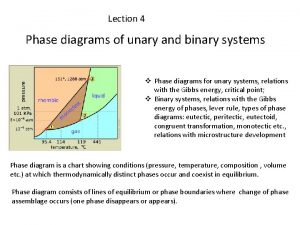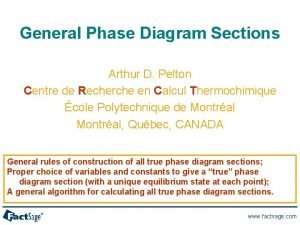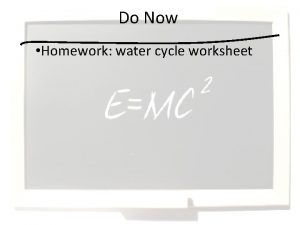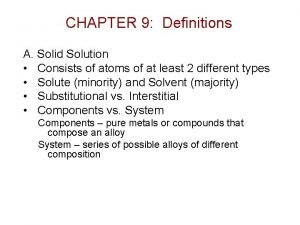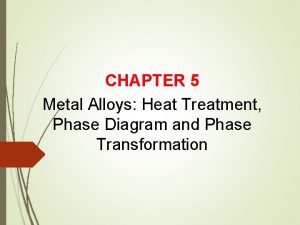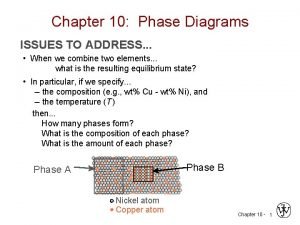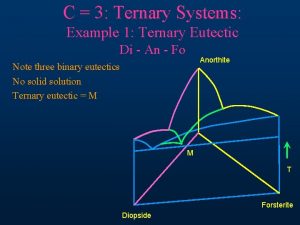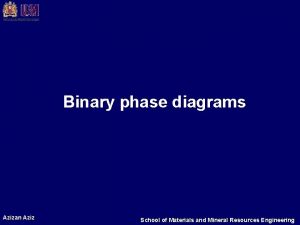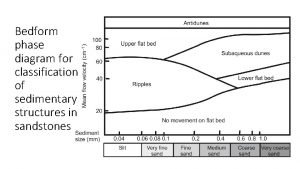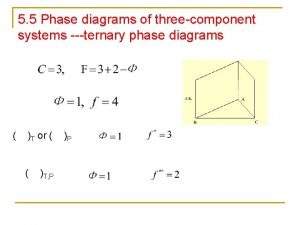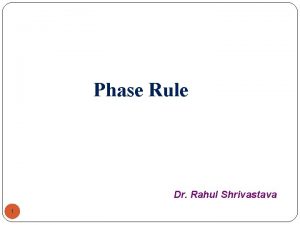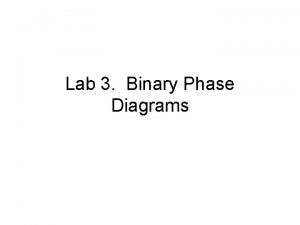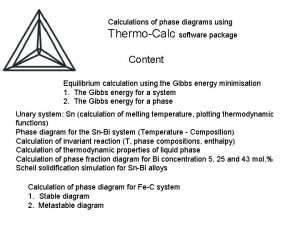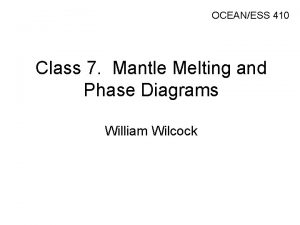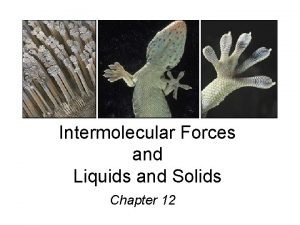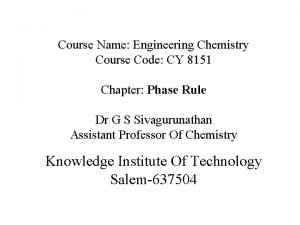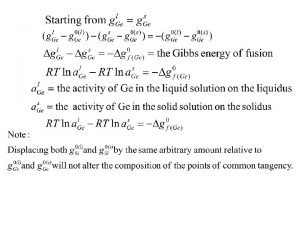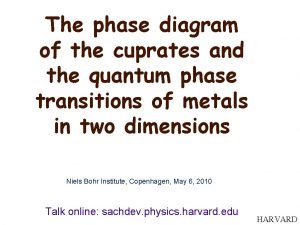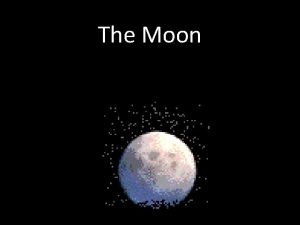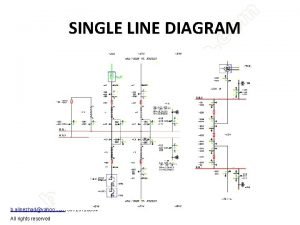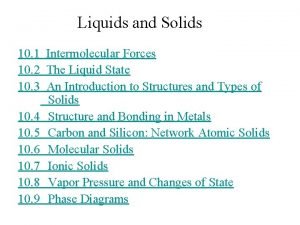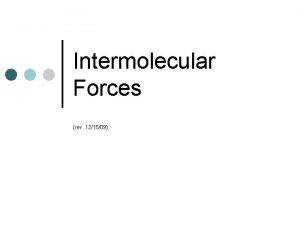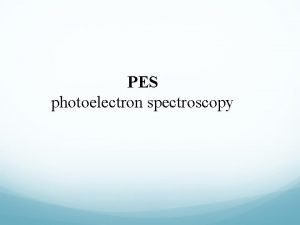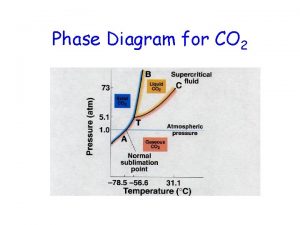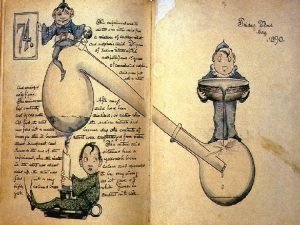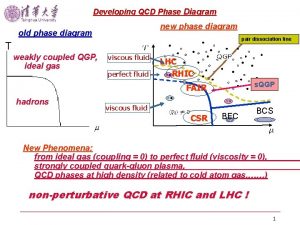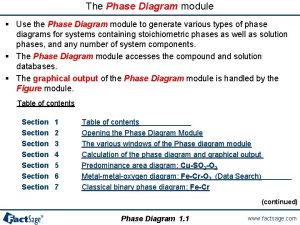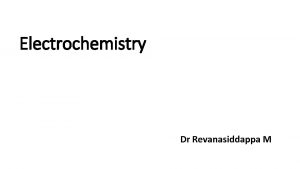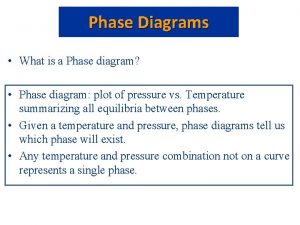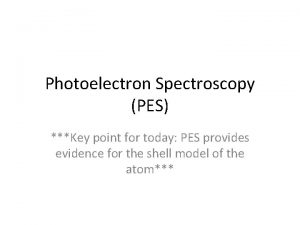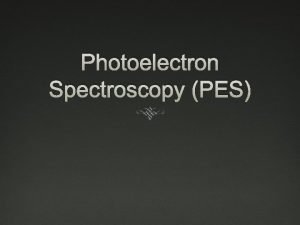Phase diagram Dr Revanasiddappa M Professor PES University




















































- Slides: 52

Phase diagram Dr Revanasiddappa M Professor PES University Electronic city campus

Introduction • A phase is defined as any homogeneous and physically distinct part of a system bounded by a surface and is mechanically separable from other parts of the system. • A phase may be gaseous, liquid or solid. It is perfectly homogeneous and distinct from every other phase that is present in the system. There must be a definite boundary between any two phases. This boundary is known as the interface. • Air constitutes a single phase only as it contains a mixture of nitrogen, oxygen, carbon dioxide, water vapour etc. , . A system consisting of only one phase is said to be homogeneous. • A mixture of two immiscible liquids such as water and benzene, will exist in two distinct liquid phases and in addition there will be a vapour phase. Thus there will be three phases each separated from the other by a well-defined bounding surface.

• A system consisting of more than one phase is said to be heterogeneous. • When various phases are in equilibrium with one another in a heterogeneous system, there can be no transfer of energy or mass from one phase to another. • This means that at equilibrium, the various phases must have the same temperature and pressure and their respective compositions must remain constant all along.

Derivation of Williard Gibbs • The phase rule was given by Williard Gibbs in 1876 is based on the principles of thermodynamics. It is a mathematical equation that relates the number of degrees of freedom, components and phases. • It describe the mathematical relationship for determining the stability of the phases present in material at equilibrium condition. • Degrees of the freedom of the system=Total number of independent variables. • For example in TWO component system A and B (Binary alloys) • Condition for equilibrium: • Similarly

• For “C” Components • Total No Variables in a system = Composition variables + External Variables (P, T) = PC+2 • Actual variables in a system = P(C-1) +2. . . . . (1) • For Example Fe-C two component system. C-1 component present in Phases. • Fixed variables =(P-1)C. . . (2) • Total number of Independent variables = PC-P+2 -PC+C • F=C-P+2 • P+F = C+2 • Mathematically it is stated as “for a heterogeneous system in equilibrium, the number of phases (P) plus the number of degrees of freedom (F) is equal to the number of components plus 2”

Phase (P) • A phase is defined as “ an homogeneous, physically distinct and mechanically separable portion of system, which is separated from other such parts of the system by definite boundary surfaces” • Example for single phase systems: • Air constitutes a single phase only as it contains a mixture of nitrogen, oxygen, carbon dioxide, water vapour. • Water and Alcohol • Example for two phase systems: • Saturated solution of Na. Cl • Immiscible liquids Benzene and Water • A liquid and vapour: Acetone and its vapour • A mixture of two solids: Ca. CO 3 and Ca. O • Example for three phase system

Component (C) • Component is defined as “the smallest number of independently variable constituents, by means of which the composition of each phase can be expressed in the form of a chemical equation”. • Example : • i) In the water system, • The chemical component of all the three phases is H 2 O and therefore it is one component system. • Ethanol and Water: Two component system but one phase Ethanol Water • A mixture of kerosene and water which are immiscible is a two phase two component

Degree of freedom • Degree of freedom is defined as the minimum number of independent variable factors such as temperature, pressure and concentration of the phases, which must be fixed in order to define the condition of a system completely. • If F= 1 Univariant or monovariant system • If F=2 Bi-variant • If F= 3 Ttrivariant • If F=0 Non-variant

Phase Diagram • The conditions under which different phases of a heterogeneous system are in equilibrium and also stable can be represented graphically. This graphical representation is known as phase diagram. • In one component system a graph of pressure against temperature is used to show the equilibrium between different phases. Example: H 2 O system • In a two component system, a graph of composition against temperature is used to show the equilibrium between different phases. Example: Lead-silver system

Merits of the Phase rule Ø It is applicable to both physical and chemical equilibria. Ø It requires no information regarding molecular/micro-structure, since it is applicable to macroscopic systems. Ø It is a convenient method of classifying equilibrium states in terms of phases, components and degrees of freedom. Ø It helps us to predict the behaviour of a system, under different sets of variables. Ø It indicates that different systems with same degree of freedom behave similarly. Ø It helps in deciding whether under a given set of conditions : Ø a) various substances would exist together in equilibrium (or) Ø b) some of the substances present would be interconverted or Ø c) some of the substances present would be eliminated.

Limitations of Phase rule: Ø It can be applied only for system in equilibrium. Consequently, it is of little value in case of very slow equilibrium state attaining system. Ø It applies only to a single equilibrium system; and provide no information regarding any other possible equilibria in the system. Ø It requires at most care in deciding the number of phases existing in an equilibrium state, since it considers only the number of phases, rather than their amounts. Thus even if a trace of phase is present, it accounts towards the total number of phases. Ø It conditions that all phases of the system must be present simultaneously under the identical conditions of temperature and pressure. Ø It conditions that solid and liquid phases must not be in finelydivided state; otherwise deviations occurs.

Application of phase rule to water system (one component system) • The water system is a one component system Since water exists in three possible phases such as solid, liquid and vapour, there are three forms of equilibria : ØLiquid – vapour Øsolid - vapour Ø solid - liquid ØEach equilibrium involves two phases. The nature of these phases which exist in equilibrium at any time depends on the conditions of temperature and pressure.

One component system. . . 1. Curves : There are three curves OA, OB and OC. 2. Areas : Three curves OA , OB and OC divide the diagram into three areas AOB, AOC and BOC. 3. Triple point : The above three curves meet at the point O and is known as triple point. 4. Metastable equilibrium : The curve OA represents the metastable equilibrium.

One component system. . . 1) Curve OA • The curve OA is called vaporization curve, it represents the equilibrium between water and vapour. At any point on the curve the following equilibrium will exist. • The degree of freedom of the system is one, i. e. univariant. Thus applying phase rule equation, F=C–P+2=1– 2+2; F=1 • This equilibrium (i. e, line OA ) will extend up to the critical temperature ( 3740 C). Beyond the critical temperature the equilibrium will disappear only water vapour will exist.

One component system. . . 2)Curve OB • The curve OB is called sublimation curve of ice, it represents the equilibrium between ice and vapour. At any point on the curve the following equilibrium will exist. • The degree of freedom of the system is one, i. e. , univariant. • This is predicted by the phase rule. • F=C–P+2; F=1– 2+2; F=1 • This equilibrium line will extend upto the absolute zero(– 2730 C ) where no vapour can be present and only ice will exist.

One component system. . . 3) Curve OC • The curve OC is called melting point curve of ice, it represents the equilibrium between ice and water. At any point on the curve the following equilibrium will exist. • The curve OC is slightly inclined towards pressure axis. This shows that melting point of ice decreases with increase of pressure. • The degree of freedom of the system is one. i. e. , univariant.

One component system. . . 4) Triple point (Point ‘O’) • At triple point all the three phases namely ice, water and vapour coexist. Thus the value of P is 3. Applying phase rule equation, the degree of freedom at this point is zero. It means that three phases can coexist in equilibrium only at a definite temperature and pressure. The values are 0. 00750 C and 4. 58 mm respectively. F=C-P+2 F=1 -3+2=0 • At this triple point, neither pressure nor temperature can be altered even slightly without causing the disappearance of one of the phases. The triple point is not the same as the ordinary melting point of ice ( i. e, 00 C). It’s value has been increased due to the fact that 00 C is the melting point of ice at 760 mm of mercury and a decrease of 4. 58 mm will rise the melting point to 0. 00750 C.

One component system. . . 5)Curve OB ( Metastable equilibrium) • The curve OB is called vapour pressure curve of the super-cool water or metastable equilibrium. • Where the following equilibrium will exist. • Sometimes water can be cooled below 00 C without the formation of ice, this water is called super-cooled water. Supercooled water is unstable and it can be converted into solid by ‘seeding’ or by slight disturbance.

One component system. . . 6) Areas • Area AOC, BOC , AOB represents water ice and vapour respectively. In order to define the system at any point in the areas, it is essential to specify both temperature and pressure. The degree of freedom of the system is two. i. e. , Bivariant. • This is predicted by the phase rule F = C – P + 2; F = 1 – 1 +2 ; F = 2

One component system. . . Uses of Phase diagram 1. From the phase diagram, it is possible to predict whether an eutectic alloy or a solid solution is formed on cooling a homogeneous liquid containing mixture of two metals. 2. The phase diagrams are useful in understanding the properties of materials in the heterogeneous equilibrium system. 3. The study of low melting eutectic alloys, used in soldering, can be carried out using phase diagrams.

Two component system • Reduced phase rule or condensed phase rule. We know the phase-rule equation, F=C-P+2 ……… (1) Two component system • For a two component system, C = 2 and hence the above equation becomes, • F = 2 – P + 2 = 4 – P ……… (2) • The minimum number of phases in any system at equilibrium is one. It is clear from the equation (2) , the maximum number of degree of freedom is three. • Thus, three variables – pressure, temperature and composition of one of the components must be specified to describe the system. This will lead to three dimensional figures which cannot be conveniently represented on a paper. To make this simple, one of the three variables is kept constant.

Two component system. . . • In solid-liquid equilibrium of an alloy , practically there is no gaseous phase and the pressure will not have much influence. In the case of solidliquid equilibrium, the experiments are generally carried out at constant pressure. • Thus the system in which only the solid and liquid phases are considered and the gas phase is ignored is called a condensed system. This reduces the degree of freedom of the system by one. The phase rule equation is then written as • F’ = C – P + 1 • This equation is called reduced phase rule or condensed phase rule. For a two component system the phase rule equation is written as • F’ = C – P + 1 • = 2 – P +1 = 3 – P ……… (4) • The above equation is known as the reduced ( condensed) form of phase rule for two component system.

Two component system. . . . • There are various types of solid-liquid equilibria of which only two of them are taken here. • 1. Those equlibria in which the components are completely miscible with one another in liquid state. They do not form any compound on solidification. They give rise to merely an intimate mixture known as eutectic. • Some examples of this system are 1) lead-silver system 2) Lead-Antimony system 3) Zinc-cadmium system 4) Potassium iodide- water system

Two component system. . . . 2. Those equilibria in which the components enter into chemical combination. They give rise to one or more compounds. Examples of this system are : 1) Zinc-magnesium system 2) Calcium chloride – Potassium chloride system 3) Gold-Tellurium system.

Two component system. . . . • Classification of two component system The two component systems are classified into the following three types : i) Simple eutectic formation ii) a) Formation of compound with congruent melting point. b) Formation of compound with incongruent melting point. iii) Formation of solid solution. i) Simple eutectic formation : • A system with two substances which are completely miscible in the liquid state , but completely immiscible in the solid state is known as eutectic system. In this system the substances do not react chemically.

Two component system. . . • Among the mixtures of different proportions of two substances, the mixture which has the lowest melting point is known as the eutectic mixture. • The temperature and composition corresponding to the point eutectic point is called eutectic temperature and eutectic composition respectively.

Two component system. . . • Simple eutectic systems • The general phase diagram for binary alloy systems is shown in Fig. Here the pressure does not have the considerable effect. Hence, the other two variables viz, temperature and compositions are taken into account. • Components A and B. • When small quantities of B are added to A gradually, the melting point of A falls along the curve AC. In the same way when small quantities of A are added to B gradually, the melting point B falls along the curve BC. Hence, AC and BC are the freezing point curves of A and B respectively.

Two component system. . .

Two component system. . . • The curves AC and BC meet at the point C. At this point the three phases solid A, solid B and their solution coexist. The degree of freedom is zero here and the system is therefore invariant. Also only at this point C, the liquid can exist at the lowest temperature. Since the mixture of components A and B of composition corresponding to the point C has the lowest melting point, the point C is called the eutectic point. • The temperature and composition corresponding to the point C is called eutectic temperature and eutectic composition respectively.

Two component system. . . • Consider a liquid mixture of composition represented by a point alpha cooled at constant pressure. The temperature falls without any change of composition until the point beeta on the curve AC is reached. At this temperature t 1, the solid A will separate out. The system now consists of two phases and hence monovariant. As cooling continues, the component A keeps on separating out and the solution becomes relatively richer in B. The temperature and the solution composition both change along AC. • Thus at the temperature t 1, solid A is in equilibrium with solution of composition X and at temperature t 2, it is in equilibrium with solution of composition Y. It is clear therefore, in the area ACD, solid A is in equilibrium with solutions of varying composition given by the curve AC depending upon the temperature.

Two component system. . . • When the temperature reaches a point delta represented by, the solid B also begins to separate out. On further cooling the system, solid A and B separate out together in constant ratio so that the composition of the solution remains constant. The temperature also remains constant for some time. • When the liquid solution has been completely solidified and the system consists only of a mixture of solid A and B, it becomes monovariant. Further cooling will result in the fall of temperature below the line DD into the area in which only the two solids coexist as shown. • In the same way , if the composition of liquid mixture is on the right of the eutectic point C, as represented by point ‘’, similar series of changes will be obtained on cooling. • In the same way , if the composition of liquid mixture is on the right of the eutectic point C, as represented by point ‘alpha’, similar series of changes will be obtained on cooling.

Construction of Phase diagram by Thermal analysis (or) cooling curve • Thermal analysis is a method involving a study of the cooling curves of various compositions of a system during solidification. The shape of the freezing point curves for any system, especially those involving metals can be determined by thermal analysis. • The data obtained from thermal analysis along with recorded curves are called as thermogram. • These thermograms are characteristic of a particular system composed of either single or multi component materials. • Thermograms indicate the system in terms of temperature, dependencies of it’s thermodynamic properties. • Let us discuss in detail the cooling curves or time-temperature curves of some simple systems.

Cooling curve. . . . . a Fig represents cooling curve of a pure solid

Cooling curve. . . . . Example 1 : • If a pure substance say x , in molten state is cooled slowly and the temperature is noted at different time interval. The graph plotted between temperature and time (the cooling curve) will be of the form shown in Fig. • In this diagram ab denotes the rate of cooling of molten liquid and the liquid starts solidifying at the freezing point b. Now the temperature remains constant until the liquid melt is completely solidified. Solidification completes at the point ‘c’. • The horizontal line ‘bc’ represents the equilibrium between the solid and liquid melt. After the point ‘c’, the temperature of the solid begins to decrease along the curve ‘cd’.

Cooling curve. . . . . Fig shows the cooling curve of a mixture A+B

Cooling curve. . . . . Example 2 : • When a molten liquid containing two components ( say A and B) is cooled slowly then the cooling curve is different and one such curve is shown in Fig. • As before, initially the rate of cooling is continuous. When it reaches the point ‘b’ one substance ( either A or B) begins to solidify out of the melt, which is indicated by a break and the rate of cooling is different. • On further cooling at the break point ‘c’ the second compound also begins to solidify. Now the temperature remains constant until the liquid melt is completely solidified, which forms the eutectic mixture (line cd). • After the break point ‘d’ cooling of solid mass begins. The temperature of horizontal line ‘cd’ gives the eutectic temperature.

Cooling curve of various compositions of two solids

• A number of mixtures of A and B are taken with different composition. • Each mixture is heated to the molten state and their cooling curves are drawn separately for each mixture. • From the cooling curves of various compositions, the main phase diagram can be drawn by taking the composition in X-axis and temperature in Y-axis. • Any point on this line indicates the appearance of the solid phase from the liquid. The area above this curve is only liquid phase.

Uses of Cooling curves • Cooling curves are used to find the percentage purity of the compounds. • It is used to find the melting point of the compounds • Thermal analysis is useful in derivation of phase diagram of any two component system • Used to find the composition of the alloy. • Used to analyse the behaviour of the compounds.

Lead –Silver system • It is a two component system. The two metals are completely miscible in liquid state and do not form any compound. There is almost no effect of pressure on this system. The temperaturecomposition phase diagram is shown in Figure. It contains lines, areas and the eutectic point.

Lead –Silver system. . . 0% Ag 0% Pb 97. 4% Pb Lead silver system

Lead –Silver system. . . The curve AC: • The curve AC is the freezing point curve of pure lead. The melting point of lead decreases gradually along the curve AC, with the continuous addition of silver. • Thus the curve AC is showing the effect of addition of silver on the melting point of pure lead. • All along the curve AC two phases –solid lead and liquid are in equilibrium. • According to reduced phase rule equation F’ = C – P + 1 =2– 2+1=1 i. e, F’ = 1 i. e. , the system is univariant.

Lead –Silver system. . . ii) The curve BC • Curve BC is the freezing point curve of pure silver and represents the effect of addition of pure lead on the melting point of pure silver. All along the curve BC two phases –solid silver and liquid are in equilibrium. • According to reduced phase rule equation. • F’ = C – P + 1 • = 2 – 2 + 1 = 1, i. e. F’ = 1 ( The system is univariant ) iii) Point C ( Eutectic point) • Point C is the eutectic point where solid silver, solid lead and their solution coexist. The curves AC and BC meet at point C. Since the experiment is carried out at constant pressure, the number of degree of freedom for the system at the eutectic point C is zero on the basis of reduced phase rule.

Lead –Silver system. . . F’ = C – P + 1 = 2 – 3 + 1 = 0 ; i. e. , F’ = 0 • The system is non-univariant. Eutectic composition is 2. 6% , silver and 97. 4% lead and the corresponding temperature is 576 K. iv) Areas • The area above the line ACB has a single phase (molten Pb + Ag). • According to reduced phase rule equation, F’ = C – P + 1 ; = 2 – 1 + 1 = 2 ; i. e. , F’ = 2 • The system is bivariant. Both the temperature and composition have to be specified to define the system completely. • The area below the line AC ( solid Ag + liquid melt), below the line BC ( solid Pb +liquid melt) and below the eutectic point ‘C’ have two phases and the system is univariant. • According to reduced phase rule equation, • F’ = C – P + 1 ; = 2 – 2 + 1 = 1 i. e. , F’ = 1

Lead –Silver system. . . Application of Pattinson’s process : • The phase diagram of lead-silver is useful in the extraction of silver from the argentiferous lead ore which has a very small percentage of silver. This process is known as Pattinson’s process. • Let x represent the molten argentiferous ( Pb + Ag alloy) lead containing very small amount of silver in it. It is a homogeneous liquid and on cooling, the temperature falls but without change in concentration till any point y on the curve AC is reached. • On further cooling, lead begins to separate out and the solution becomes richer in silver. Further cooling will shift the system along the line yc. More of lead separates as solid till the point C is reached when the percentage of Ag rises to 2. 6%. This process of increasing the relative proportion of silver in the alloy is known as Pattinson’s process of desilvering of lead.

Lead –Silver system. . . Uses of Eutectic system : 1. Eutectic systems are useful in predicting the suitable alloy composition. 2. It is used in the preparation of solders which are used for joining two metal pieces together.

Iron carbon system • Allotropy of Iron: Iron exists in three allotropic forms namely, alpha iron (α-Fe), gamma iron (γ-Fe) and delta iron (δ-Fe). α-Fe: It is stable below 9500 C and has a bcc structure. It is ferromagnetic but loses this property at 7680 C which is called as curie temperature. It dissolves very little carbon (0. 001%) at room temperature and 0. 02% at 7230 C. • The solid solution of carbon in α-Fe is called ferrite. γ-Fe: At 9100 C, changes into another allotrope γ-Fe which is satble upto 14000 C. It has a fcc structure. • It dissolves relatively high amount of carbon, 0. 8% at 7230 C and 1. 7% at 11300 C. The solid solution of carbon in γ-Fe is called austenite. δ-Fe: At 14000 C, γ-Fe changes to δ-Fe. This is stable up to 15350 C. It has bcc structure which is similar to that of α-Fe.

Iron carbon system. . . . Phase diagram of Iron-Carbon (Fe-C) System

Iron carbon system. . . . • The Fe-C is a two component system involving solid-solid phase transition. • The phase diagram is a plot of temperature against the amount of C dissolved in Fe (composition). • It consists of several areas, lines and points. • Areas: From condensed phase rule these • ACB = Liquid only two are Bivariant system • ADOF = only austenite • ACD ( liquid and austenite) • BCE (liquid and cementite) From condensed phase rule these two are univariant system because two phase system.

Iron carbon system. . . . Lines: • Consider the lines AC and BC. Along the line AC, on cooling, the solubility of carbon increases indicating the transformation δ-Fe into austenite. Along the line BC, the solubility of carbon decreases. • The excess carbon that separates combines with iron forming Fe 3 C. The iron carbide formed is called cementite. • Below the lines DCE, the Fe-C system will be in the solid state. As the austenite phase cools, the structure of iron changes to ferrite. • Simultaneously the excess carbon is precipitated as cementite. This occurs along the line DO. Ferrite and cementite crystals grow side by side to give structure of pearlite; pearlite consist of alternate layers of ferrite and cementite.

Iron carbon system. . . . Points: • Point C is called eutectic point. It is a point where austenite, cementite and liquid are in equilibrium each other. • At this point temperature and composition are fixed at 11300 C and 95. 7% Fe and 4. 3% C respectively. • From phase rule, system at point C is invariant. • Point O is called the eutectoide point. It is the point where austenite, ferrite and cementite are in equilibrium with each other. • At this point temperature and composition are fixed at 7230 C and 99. 17% Fe and 0. 83% C respectively. • From phase rule, system at point O is invariant. • Point D indicates the maximum solubility of carbon in solid Fe (1. 7%). • Eutectoid point refers to a separation of a solid with a fixed composition at a fixed temperature from another solid.

Iron carbon system. . . . Significance of Iron carbon system • It is used tailor properties of steel and to heat treat them. • It is also used for comparison of crystal structures for metallurgists in case of rupture or fatigue Phase Crystal structure Characteristics Ferrite BCC Soft, ductile, magnetic Austenite FCC Soft, moderate strength, non-magnetic Cementite Compound of Iron & Carbon Fe 3 C Hard &brittle
 Promotion from associate professor to professor
Promotion from associate professor to professor Normal phase vs reverse phase chromatography
Normal phase vs reverse phase chromatography M tswett pronunciation
M tswett pronunciation Mobile phase and stationary phase
Mobile phase and stationary phase What is mobile and stationary phase
What is mobile and stationary phase Normal phase vs reverse phase chromatography
Normal phase vs reverse phase chromatography Difference between phase voltage and line voltage
Difference between phase voltage and line voltage Chromatography mobile phase and stationary phase
Chromatography mobile phase and stationary phase In a triangle connected source feeding a y connected load
In a triangle connected source feeding a y connected load Csce 441
Csce 441 University oaks utsa phase 3
University oaks utsa phase 3 Concentric winding diagram
Concentric winding diagram Neptune uranus
Neptune uranus Isopleth phase diagram
Isopleth phase diagram Sgte phase diagram
Sgte phase diagram Explain congruent melting point
Explain congruent melting point Thymol salol phase diagram
Thymol salol phase diagram Eutectic and eutectoid reaction
Eutectic and eutectoid reaction Unlabeled phase diagram
Unlabeled phase diagram Eutectic and eutectoid reaction
Eutectic and eutectoid reaction Pattinson process phase diagram
Pattinson process phase diagram Di an fo ternary phase diagram
Di an fo ternary phase diagram Metamorphic rock phase diagram
Metamorphic rock phase diagram Mineral assemblage
Mineral assemblage Unary and binary phase diagram
Unary and binary phase diagram Unary system phase diagram
Unary system phase diagram Factsage
Factsage Phase changes worksheet
Phase changes worksheet Congruent and incongruent melting
Congruent and incongruent melting Lever rule fe-c phase diagram
Lever rule fe-c phase diagram Solid solution
Solid solution Lever rule
Lever rule Solvus temperature
Solvus temperature Gibbs phase rule
Gibbs phase rule Bedform phase diagram
Bedform phase diagram Three component system phase diagram
Three component system phase diagram Phase rule
Phase rule Binary peritectic phase diagram
Binary peritectic phase diagram Phase diagram software
Phase diagram software Monopulse radar block diagram
Monopulse radar block diagram Qgp phase diagram
Qgp phase diagram Olivine phase diagram
Olivine phase diagram How does a salt forms?
How does a salt forms? Intermolecular forces
Intermolecular forces Define degree of freedom
Define degree of freedom Pressure composition phase diagram
Pressure composition phase diagram Bond wave
Bond wave Whats the moon made of
Whats the moon made of Single line diagram 3 phase
Single line diagram 3 phase Phase diagram for carbon dioxide
Phase diagram for carbon dioxide Heating curve of water
Heating curve of water Phase change diagram endothermic exothermic
Phase change diagram endothermic exothermic Phase change triangle diagram
Phase change triangle diagram











